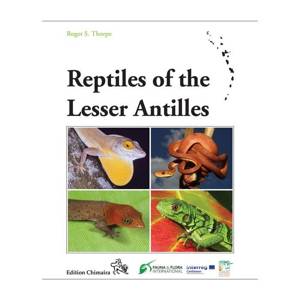
Door een staking bij bpost kan je online bestelling op dit moment iets langer onderweg zijn dan voorzien. Dringend iets nodig? Onze winkels ontvangen jou met open armen!
- Afhalen na 1 uur in een winkel met voorraad
- Gratis thuislevering in België vanaf € 30
- Ruim aanbod met 7 miljoen producten
Door een staking bij bpost kan je online bestelling op dit moment iets langer onderweg zijn dan voorzien. Dringend iets nodig? Onze winkels ontvangen jou met open armen!
- Afhalen na 1 uur in een winkel met voorraad
- Gratis thuislevering in België vanaf € 30
- Ruim aanbod met 7 miljoen producten
Zoeken
Omschrijving
This book covers the reptiles of the Lesser Antillean archipelago, from Sombrero in the north down to the Grenada bank in the south. Following the Preface and Acknowledgments, the book is organized into five sections: 1) Introduction, 2) Taxa, 3) Island Banks, 4) Biogeography and 5) Conservation. The taxa are considered in an arbitrary sequence: anoles, iguanas, curlytails, skinks, teiids, microteiids, dwarf geckos, larger geckos, anguids and amphisbaenids, blindsnakes and threadsnakes, boas, pit vipers, colubrids, chelonids and crocodilians. Widespread species are described in this section rather than repeatedly in the Island Banks section. In the latter section each of the island banks are considered from north to south (Sombrero, Anguilla Bank, Saba, St. Kitts Bank, Antigua Bank, Redonda, Montserrat, Guadeloupe Bank, MarieGalante, Les Saintes, Dominica, Martinique Bank, St. Lucia Bank, Barbados, St. Vincent Bank, Grenada BankGrenadines, Grenada BankGrenada). The Grenadines and Grenada plus satellites are treated in separate chapters. The taxa in this section are dealt with in the same order as the Taxa section, and, where appropriate, I have attempted to illustrate and explain the sometimesconsiderable variation that occurs within an island species. The intention is that the chapter on each island bank could act as a field guide, with identification aided by the numerous images. I have attempted to make each island bank chapter independent and to include images of every native and introduced species found on each bank, without, duplicating too many identical images for the more widespread species. For native species/radiations, an attempt has been made to allocate the source of colonization as either the Greater Antilles or the mainland. Our understanding of Lesser Antillean reptiles and their conservation is rapidly changing. Ongoing conservation threats like hybridization (e.g., iguanas) and recent invasive species (e.g., Anolis/Ctenonotus cristatellus in Dominica) can rapidly change the situation. Molecular phylogeny and major taxonomic revisions, such as the revision of skinks (Hedges & Conn 2012), dramatically change our understanding of the relationships, biogeography and nomenclature.
Specificaties
Betrokkenen
- Auteur(s):
- Uitgeverij:
Inhoud
- Aantal bladzijden:
- 608
- Taal:
- Engels
- Reeks:
- Reeksnummer:
- nr. 88
Eigenschappen
- Productcode (EAN):
- 9783899731231
- Verschijningsdatum:
- 28/07/2022
- Uitvoering:
- Hardcover
- Afmetingen:
- 160 mm x 20 mm
- Gewicht:
- 1400 g

Alleen bij Standaard Boekhandel
+ 252 punten op je klantenkaart van Standaard Boekhandel
Beoordelingen
We publiceren alleen reviews die voldoen aan de voorwaarden voor reviews. Bekijk onze voorwaarden voor reviews.











